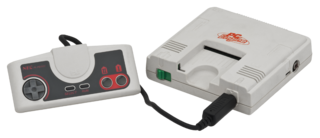PC Engine
From NEC Retro
Revision as of 07:39, 11 October 2015 by Black Squirrel (talk | contribs)

| ||||||||||
| PC Engine | ||||||||||
|---|---|---|---|---|---|---|---|---|---|---|
| Manufacturer: NEC | ||||||||||
|
This teeny-tiny article needs some work. You can help us by expanding it.
The PC Engine (PCエンジン) is a video game console originally released by NEC in Japan in October 1987. It stands as NEC's first foray into the lucrative video games market, becoming a joint venture with Hudson Soft, creator of the system's primary form of media, the HuCard. It was designed primarily to compete with Nintendo and its immensely popular Famicom machine, though found itself up against more powerful systems such as the Sega Mega Drive and Super Famicom.
Prior to the PC Engine's launch, NEC had gained experience and a large market share in the home computer market primarily with its PC-8800 series and PC-9800 series.
Hardware
For a while, the PC Engine held the record for the smallest video game console ever produced - a white box with a single controller port, power switch and HuCard slot for playing games.
Technical Specifications
History
Development
Release
NEC notoriously changed its mind several times over the idea of selling the PC Engine in Europe, but while the UK and Spain eventually saw the console in the form of the TurboGrafx, France was given a supply of slightly modified PC Engine consoles through a locally-formed distributor, Sodipeng.
Legacy
While never a market leader, the PC Engine was a huge success in Japan, comfortably fending off Sega and its challenger in the Sega Mega Drive (and later Sega Mega-CD), but being put under pressure with Nintendo's Super Famicom in the early 1990s. As well as being the logical home for games produced by Hudson Soft, it became the system of choice for other developers such as Namco.
However, its Japanese success was never successfully emulated elsewhere, trailing a distant third behind Nintendo and Sega in the form of the TurboGrafx-16 or TurboGrafx. As such, while its impact on the Japanese gaming market is significant, the console was largely unheard of in the Western world until the advent of easily accessible internet connections.
NEC tried to succeed the PC Engine with the PC Engine SuperGrafx, and then again with the PC-FX. Neither system saw the same level of success.
| PC Engine |
|---|
| PC Engine (1987) | CoreGrafx (1989) | CoreGrafx II (1991) X1 Twin (1987) | PC-KD863G (1988) | Shuttle (1989) | GT (1990) | LT (1991) |
| Add-Ons |
| AV Booster (1988) | Interface Unit (1988) | Ten no Koe 2 (1989) | Backup Booster (1989) | Backup Booster II (1989) | Ten no Koe Bank (1991) | Memory Base 128 (1993) |